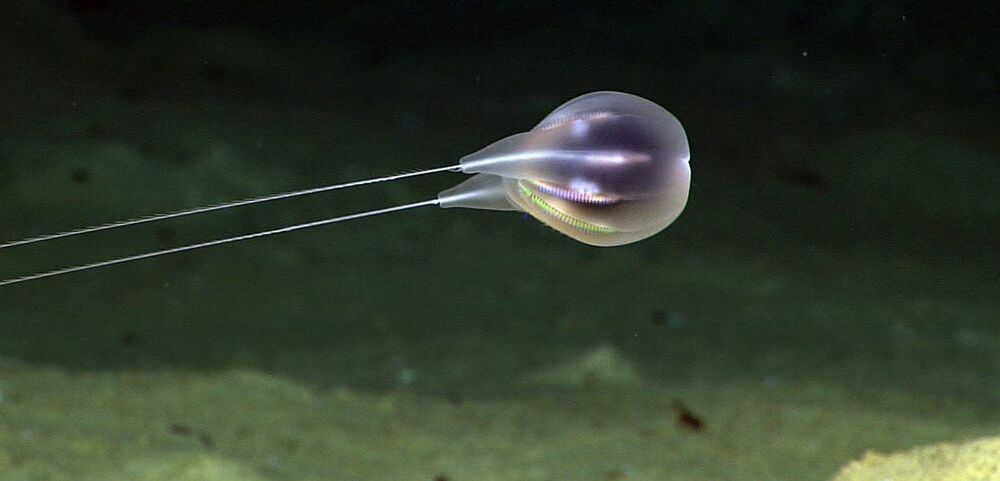Nov 30, 2020
50-year Mystery of Protein Folding Solved by AI
Posted by Future Timeline in categories: biological, robotics/AI
Protein folding, one of the biggest mysteries in biology, has been solved by artificial intelligence company DeepMind.
Protein folding, one of the biggest mysteries in biology, has been solved by artificial intelligence company DeepMind.

For the first time, scientists with the National Oceanic and Atmospheric Administration (NOAA) have formally identified a new species of undersea creature based solely on high-definition video footage captured at the bottom of the ocean.
And what an undersea creature it is. Meet Duobrachium sparksae – a strange, gelatinous species of ctenophore, encountered by the remotely operated vehicle (ROV) Deep Discoverer during a dive off the coast of Puerto Rico.
Synthetic biology tools used to engineer T cells that work like living computers and recognize antigen combinations in solid tumors.
Plant scientists have revolutionised science and innovation. Research around the cell or cell biology was born out of plant science.
Researching plants is vital for our food security, maintaining our ecosystems and in our fight against climate change. Plant science is equally important to generate new knowledge that breaks disciplinary barriers to revolutionise several fields of research and innovation. But despite its valuable contribution, scientists and prospective young scientists often overlook plant science. It’s because of this low recognition, plant science doesn’t get the same prestige as other disciplines. This is detrimental to the future of plant science as bright young students continue to choose a career away from plant science. I never considered studying plants myself — it was entirely accidental that I studied plant science.
In other words, scientists and prize committees question the influence of basic plant science across different disciplines.
Continue reading “Plant science: overlooked research area that gave birth to cell biology” »
Computational molecular physics (CMP) aims to leverage the laws of physics to understand not just static structures but also the motions and actions of biomolecules. Applying CMP to proteins has required either simplifying the physical models or running simulations that are shorter than the time scale of the biological activity. Brini et al. reviewed advances that are moving CMP to time scales that match biological events such as protein folding, ligand unbinding, and some conformational changes. They also highlight the role of blind competitions in driving the field forward. New methods such as deep learning approaches are likely to make CMP an increasingly powerful tool in describing proteins in action.
Science, this issue p.
### BACKGROUND
Circa 2014
Forget blue whales and giant redwood trees. The biggest living organism is over 2 miles across, and you’ll hardly ever see it.
Subramanian Sundaram, a biological engineer affiliated with both Boston University and Harvard has been looking into the current state of robot hands and proposed ideas regarding where new research might be heading. He has published a Perspective piece in the journal Science outlining the current state of robotic hand engineering.
By almost any measure, robot hand design has evolved into sophisticated territory—robot hands can not only pick things up and let them go, they can sometimes “feel” things and respond in human-like ways—and in many cases, do it with extreme dexterity. Unfortunately, despite substantial inroads to giving robot hands human-like abilities, they still fall far short. Sundaram notes that one area where they need major improvement is in sensing things the way humans do, namely: feeling pressure, temperature and that hard-to-classify sense, pleasure. You cannot tickle a robot hand, for example, and expect a human-like response. Sundaram explains in great detail what is known about the human hand and how it processes sensations, and suggests that robot analogs might possible. He notes that not everything about a robot hand needs to be done in the same way as the human hand.
Some of the greatest medical discoveries of the 20th century came from physicists who switched careers and became biologists. Francis Crick, who won the 1962 Nobel Prize in Physiology and helped identify the structure of DNA, started his career as a physicist, as did Leo Szilard who conceived the nuclear chain reaction in 1933, writing the letter for Albert Einstein’s signature that resulted in the Manhattan Project that built the atomic bomb, but spent the last decades of his life doing pioneering work in biology, including the first cloning of a human cell.
Today, a group of world-renowned researchers at the Perimeter Institute for Theoretical Physics with expertise from cosmology to quantum gravity are using physics to help fight the COVID-19 pandemic.

Greening the Desert / De-Desertification.
Ira Pastor, ideaXme life sciences ambassador interviews Dr. Paul Elvis Tangem the Coordinator for the GGWSSI at the African Union Commission, in the executive/administrative branch of the AU, headquartered in Addis Ababa, Ethiopia.
At first glance, a pack of wolves has little to do with a vinaigrette. However, a team led by Ramin Golestanian, Director at the Max Planck Institute for Dynamics and Self-Organization, has developed a model that establishes a link between the movement of predators and prey and the segregation of vinegar and oil. They expanded a theoretical framework that until now was only valid for inanimate matter. In addition to predators and prey, other living systems such as enzymes or self-organizing cells can now be described.
Order is not always apparent at first glance. If you ran with a pack of wolves hunting deer, the movements would appear disordered. However, if the hunt is observed from a bird’s eye view and over a longer period of time, patterns become apparent in the movement of the animals. In physics, such behavior is considered orderly. But how does this order emerge? The Department of Living Matter Physics of Ramin Golestanian is dedicated to this question and investigates the physical rules that govern motion in living or active systems. Golestanian’s aim is to reveal universal characteristics of active, living matter. This includes not only larger organisms such as predators and prey but also bacteria, enzymes and motor proteins as well as artificial systems such as micro-robots. When we describe a group of such active systems over great distances and long periods of time, the specific details of the systems lose importance.